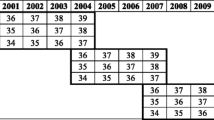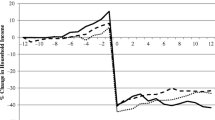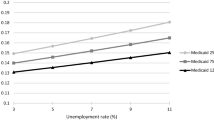Abstract
During the 1990s, 23 states implemented family cap policies as a means to reduce the incidence of out-of-wedlock births among welfare recipients. Using Current Population Survey data from 1989 to 1999, we examine the impact of family cap policies on the birth rates of single, less-educated women with children. We use the first five states that were granted waivers from the Department of Health and Human Services to implement family caps as “natural experiments.” Specifically, we compare trends in out-of-wedlock birth rates in Arkansas, Georgia, Indiana, New Jersey and Virginia to trends in states that did not implement family caps or any other waivers prior to the Personal Responsibility and Work Opportunity Reconciliation Act. We employ several techniques to increase the credibility of results from our “natural experiment,” such as the inclusion of multiple comparison groups, controls for differential time trends, and “difference-in-difference-in-differences” estimators. Our regression estimates generally do not provide evidence that family cap policies reduce the incidence of out-of-wedlock births among single, less-educated women with children.
Similar content being viewed by others
References
Acs, G. (1996). The Impact of welfare on young mothers’ subsequent childbearing decisions, Journal of Human Resources 31: 898–915.
Anderson, E. (1989). Sex codes and family life among poor inner city youths, Annals of the American Academy of Political and Social Science 501: 59–78.
Argys, L. M. & Rees, D. I. (1996). The impact of welfare generosity on the fertility behavior of recipients. Working Paper No. 9601. University of Colorado, Center for Research on Economic and Social Policy.
Bane, M. & Ellwood, D.T. (1994). Welfare Realities: From rhetoric to reform. Cambridge: Harvard University Press.
Becker, G. S. (1981). A Treatise on the Family. Cambridge: Harvard University Press.
Bertrand, M., Duflo, E. & Mullainathan, S. (2002). How much should we trust differences-in-differences estimates? National Bureau of Economic Research Working Paper No. 8841.
Camasso, M., Harvey, C., Jagannathan, R. & Killingsworth, M. (1998). A Final Report on the Impact of New Jersey's Family Development Program. New Brunswick, NJ: Rutgers University.
Crouse, G. (1999). State implementation of major changes to welfare policies, 1992– 1998, Report to the Assistant Secretary for Planning and Evaluation in the United States Department of Health and Human Services. Available from <http://aspe.os. dhhs.gov/hsp/Waiver-Policies99policy_CEA.htm>.
Department of Health and Human Services. (1997). Setting the baseline: A report on state welfare waivers. Office of the Assistant Secretary for Planning and Evaluation. Available from <http://aspe.hhs.gov/hsp/isp/Waiver2/title.htm>.
Duncan, G. & Hoffman, S. (1990). Welfare benefits, economic opportunities, and outof-wedlock births among black teenage girls, Demography 27: 519–535.
Fairlie, R. W. & London, R. A. (1997). The effect of incremental benefit levels on births to AFDC recipients, Journal of Policy Analysis and Management 16(4): 575–597.
Gallagher, L. J., Gallagher, M., Perese, K., Schreiber, S. & Watson, K. (1998). One Year After Federal Welfare Reform: A Description of State Temporary Assistance for Needy Families (TANF) Decisions as of October 1997. Washington, D.C.: The Urban Institute.
Grogger, J. & Bronars, S. G. (2001). The effect of welfare payments on the marriage and fertility behavior of unwed mothers: Results from a twins experiment, Journal of Political Economy 109(3): 529–545.
Grogger, J., Karoly, L. A. & Klerman, J. A. (2002). Consequences of Welfare Reform: A Research Synthesis. Santa Monica: RAND.
Henshaw, S. K. (1998). Abortion incidence and services in the United States, 1995–1996, Family Planning Perspectives 30(6): 263–270, 287.
Horvath-Rose, A. & Peters, H. E. (2001). Welfare waivers and non-marital childbearing, pp. 222–246, In: G. J. Duncan & P. L. Chase-Lansdale (eds.), For better and for worse: State welfare reform and the well-being of low-income families and children.New York: Russell Sage Foundation.
Joyce, T., Kaestner, R., Korenman, S. & Henshaw, S. (2004). Family cap provisions and changes in births and abortions, Population Research and Policy Review 23(5–6): 475–511 (This issue).
Kearney, M. S. (2003). Is there an effect of incremental welfare benefits on fertility behavior? A look at the family cap, Journal of Human Resources (forthcoming).
Keefe, D. E. (1983). Governor Reagan, welfare reform, and AFDC fertility, Social Service Review 57: 234–253.
Mach, T. L. (2001). Measuring the impact of family caps on childbearing decisions. Working Paper. University at Albany, State University of New York.
Maynard, R., Boehnen, E., Corbett, T., Sandefur, G. & Mosley, J. (1998). Changing family formation behavior through welfare reform, pp. 134–176, In: R. A. Moffitt (ed.), Welfare, the family, and reproductive behavior: Research perspectives. Washington, D.C.: National Academy Press.
Moffitt, R. A. (1992). Incentive effects of the U.S. welfare system: A Review, Journal of Economic Literature 30: 1–61.
Moffitt, R. A. (1998). The effect of welfare on marriage and fertility, pp. 50–97, In: R. A. Moffitt (ed.), Welfare, the family, and reproductive behavior: Research perspectives. Washington, D.C.: National Academy Press.
Powers, E. T. (1994). The impact of AFDC on birth decisions and program participation. Federal Reserve Bank of Cleveland Working Paper No. 9408.
Rank, M. (1989). Fertility among women on welfare: Incidence and determinants, American Sociological Review 54: 296–304.
Robins, P. K. & Fronstin, P. (1996). Welfare benefits and birth decisions of never married women, Population Research and Policy Review 15: 21–43.
State of Wyoming Department of Family Services (2001a). Wyoming State Plan Document: Temporary Assistance for Needy Families (TANF) Amendments, July 2001 Amendment. Available from<http://dfsweb.state.wy.us/STATEPLN/stplan07. html>.
State of Wyoming Department of Family Services (2001b). POWER Program. Available from <http://dfsweb.state.wy.us/P&P/powerpat.htm>.
Turturro, C., Benda, B., Turney, H., Chastain, J., Pollack, C., Osborn, L. & Knott, J. (1997). Arkansas Welfare Waiver Demonstration Project: Final report, July, 1994 through June, 1997. The University of Arkansas at Little Rock, School of Social Work.
United States Census Bureau. (1994). Statistical Abstract of the United States: 1994. Washington, D.C.: U.S. Government Printing Office.
United States Census Bureau. (1998). Statistical Abstract of the United States: 1998. Washington, D.C.: U.S. Government Printing Office.
United States Congress, House Committee on Ways and Means. (1992). The 1992 Green Book Overview of Entitlement Programs. Washington, D.C.: U.S. Government Printing Office.
United States Congress, House Committee on Ways and Means. (1994). The 1994 Green Book Overview of Entitlement Programs. Washington, D.C.: U.S. Government Printing Office.
United States Congress, House Committee on Ways and Means (1998). The 1998 Green Book Overview of Entitlement Programs. Washington, D.C.: U.S. Government Printing Office.
Urban Institute (2000). Assessing the New Federalism State Database. Available from <http://www.urban.org/content/Research/NewFederalism/Data/StateDatabase/ StateDatabase.htm>.
Zelnik, M. & Kantner, J. F. (1980). Sexual activity, contraceptive use and pregnancy among metropolitan-area teenagers: 1971–1979, Family Planning Perspectives 12: 230–237.
Author information
Authors and Affiliations
Rights and permissions
About this article
Cite this article
Dyer, W.T., Fairlie, R.W. Do family caps reduce out-of-wedlock births? Evidence from Arkansas, Georgia, Indiana, New Jersey and Virginia. Population Research and Policy Review 23, 441–473 (2004). https://doi.org/10.1007/s11113-004-3462-6
Issue Date:
DOI: https://doi.org/10.1007/s11113-004-3462-6




